House Darian and Kuat
The Rise of Darian
The origins of House Darian go back to the Wars of Unification. Commanders in the victorious armies that put an end to the Time of Divided Realms, the Darians gained a seat in the Reiksraade as one of the Hundred Families. When Kuat reached for the stars again, House Darian was right there at the forefront of the drive for an interstellar empire. Darian ships crossed the emptiness of interstellar space, Darian militia troops claimed land on distant planets, Darian entrepreneurs guided the flow of tribute and goods that formed the lifeblood of the emerging Kuati Hegemony. For a short, glorious time, Kuat's expansion seemed to be unstoppable. But then, Kuati starships discovered other starfaring peoples. The Coruscani, the men of Alderaan, the Duro and others. Wars erupted, warships flared up like timy suns and died, trenches criscrossed frontier worlds like Denevar and Corsin. For centuries the conflict raged. The men of Kuat fought bravely. They rode their fragile, primitive battleships into the furnace of Brentaal with Komtur Hazzo von der Darian. They held Malgil Citadel under Kommandant Rinart voner Darian. But in the end, it wasn't enough. Exhausted, starving, freezing, the commonors of Kuat rose in the Bloody Winter of 917 HR. Kuat's military forces, straining to hold at multiple fronts were able to put the revolt down- barely. The revolters failed in overthrowing the enlightened rule of the Hundred Families and the Autarch, and their workers and soldiers councils were disbanded by loyal troops, but they, and similar rebellions in other starnations were what ended the Long Wars. Twelve years later, Autarch Hronik Dreyss signed the Amalgamation Treaty that made Kuat and its Hegemony a part of the Republic.
The Dawn of the Republic
The early Republic was an era of unprecedented growth and Kuat had its share of it. The birthplace of the Republic Navy, its shipyards grew to dominate the manufacture of large warships in the whole Republic. While Kuat lost most of its political dominance over the worlds of the former Hegemony, it continued to be their economic and spiritual center. And the Great Houses, although they had lost some of their military clout with the integration of the House Fleets into the Republic Navy, with their shipyards, shipping lines and manufacturing cartels were the main motor for Kuat's economic growth. This was House Darian's golden era. A plethora of vorDarian Admirals, Generals and Administrators ensured that Darian Yards earned lucrative contracts with the navy, the Scout Service, the Diplomatic Corps and a multitude of other entities. The legendary Dromon class armored frigates, the Autocrat class ships-of-the-line and the Pride class bulk transports were all built by those shipyards in Kuat system.
The Sith Wars and the Decline of the Republic
This golden era was swept away by the firestorm of the Sith Wars. The heavy losses the Republic Navy suffered were shared by the House of Darian. Many branches of the Family died out during the conflict, owing to the strong Vordarian tradition of military service and leading from the front. When before the wars House Vordarian had boasted of 8 flag officers and 37 senior officers, barely a fifth were alive when the dust and smoke settled. With that came a loss of economic clout that hurt Darian's mercantile and shipbuilding interests. As the decades and centuries passed, this decline went on, parallel to the galaxy-wide decline of the old nobility born and raised for service and duty and their supplanting by money-grabbing merchants, such as the despicable Neimodians of the Trade Federation. Corruption, sloth and irresposibility spread through the Republic until it became a maggot-infested corpse, rotting from within, and with every passing year the cracks in the facade became wider, threatening to collapse the whole edifice under its own bloated weight. When, on the eve of the Clone Wars, the then Supreme Chancellor tried to rejuvenate the Republic with a program of reforms, it was already too late.
The Clone Wars
Such was the Galactic situation, when the Clone Wars broke out. Kuat's big shipbuilding cartels, long involved in the Techno Union, initially hailed the secession of the Confederacy of Independent Systems as the beginning of a new era. But soon, cooler minds prevailed. When the Republic mobilized its Clone Armies and the war turned against the Confederates, many on Kuat still loyal to the Republic felt their time had come. All over the planet, Kuati loyalists rose in arms to reinstate Republic control. The fighting was fierce and deadly, brother against brother, friend against friend. In space, starships fought at knife's range among the titanic shipyards. Down on the planet, Kuati House militias fought against each other and against the Autarch's forces mobilized to prevent bloodshed in vain. The fighting continued for three weeks, while Corran Vordarian, 531st Lord Darian and a Commander in Republic Intelligence led the Darian militia in a series of pitched battles from Darian valley to the outskirts of Kuat city. When a strong Republic fleet entered Kuat space, the battered Confederate forces retreated. But during their evacuation, the Confed Fleet commander gave the order to destroy as much of Kuats infrastructure as possible to deny the Republic use of the vitally important shipyards. Among those shipyards that the desperate Confederates bombarded into twisted wreckage were the Darian yards. With order restored on Kuat, the remaining militias and the Planetary Army were dissolved, their equipment and personnel incorporated into the Grand Army of the Republic. The two main pillars of Darian power and prosperity were gone.
The Rise of the New Order
When, after the defeat of the Seperatists and the restoration of order, the Chancellor declared himself Emperor and announced the beginning of a New Order, Kuat rejoiced. The wounds the war had inflicted were deep, and the galaxy needed a strong rule to restore order and prosperity, the more so because the whole bloody conflict had started out of the corruption and decay of the Republic and a senate unable and unwilling to even consider the at first legitimate concerns of what later evolved into the Seperatist movement. The last Rosom Autarch, having lost much of his prestige due to his poor handling of the situation during the ousting of the Confederates, was deposed by the Reiksraade and supplanted by an Imperial governor. But through all those reforms, the Senate clung to their privileges and prerogatives. For every two steps forward, the Senate attempted to cause the Empire to stumble one back. At last, disgusted with the Senate, the Reiksraade advised the Governor to recall Kuat's senators. Other sectors followed this example, and in the end, the Senate, which had long ceased to be of any use, was dissolved by official decree from the Emperor. Meanwhile, the House of Darian had shrunk to three persons: Corran Vordarian, 531st Lord Darian, his son Garion Vordarian, who had been exiled from the House for defying his father's wishes in choosing to marry an offworlder instead of the telbun his Lord Corran chose for him, and his grandson, Garik Vordarian, whom the Lord Darian had grudgingly named his heir.
The Fall of Darian and the Exile
While out there among the stars, the Empire grew in power and glory despite the rise of a rebel organisation called the 'Rebel Aliiance', the House of Darian quietly slipped into obscurity. Lt. Commander Garion Vordarian was lost when the Vigilant vanished without trace in the Outer Rim. Captain (ret.) Lord Corran Vordarian died when Darian Manor burned down one stormy night. Garik Vordarian, 532nd Lord Darian, by now serving in the Imperial Navy, was the sole living member of the ancient line. With Darian Manor, the last possession of the House gone, and the last old retainer of the House, a veteran of the Clone wars, buried soon afterwards, there was little left on Kuat for the young noble. In the end, that proved to be a boon, as, ill-advised by treacherous aides, His Imperial Majesty, Emperor Charon, allowed a group of Sith and their cronies, who had split from the Empire some time before, to rejoin the glorious Galactic Empire. Disgusted, Lord Vordarian turned his back on the Empire and defected to a small insurgent group affiliated with the Alliance, choosing exile. Soon, as he had expected from the start, the Emperor was treacherously disposed by the Sith cabal, and the Empire collapsed. Lord Vordarian transferred his allegiance to the Jedi Praxium, where most of the loyal Imperials had gathered to fight for the New Order against those who would pervert it for their degenerate and depraved purposes. During this time he met his beloved wife, Katya Redman-Vordarian, and a friend and leader he learned to respect and admire, as he had the Emperor, despite his alien race: the Mon Calamari Jake Azzameen, KMJP. When circumstances forced Chancellor Azzameen to resign, Lord Vordarian chose to express his gratitude and respect by adopting him into the House of Darian, only the sixth nonhuman ever adopted into a Kuati Great House.
Current State
House Darian currently consists of three branches, one main and two cadet branches.
Vordarian of Darian (senior branch)
Lord Garik Vordarian, 532nd Lord Darian
Lady Katya Redman-Vordarian
Redman of Darian (cadet branch)
Lady Katya Redman-Vordarian
Note: Lady Katya holds the predicate 'of Darian' in her own right, as she was adopted into the House of Darian prior to her engagement to the Lord Vordarian
Azzameen of Darian (cadet branch)
Sir Jake Azzameen, KMJP
Additional Information
Glossary
Amalgamation Treaty- The treaty establishing the original Republic and the Senate. Signed, among others, by Coruscant, Alderaan and Kuat.
Autarch- The Kuati head of state during the Hegemony and Republic eras, the Autarch holds the executive power. The Autarch had a voice in the Reiksraade and could also veto its decisions, but could be deposed by a three-quarters majority. Originally the first among many, the office gained more power during the Republic era due to its control of the Planetary Army as a counterweight to the House militias.
Autocrat class- A class of battleships built by Darian Yards during the early Republic era. 720m long and armed with 25 heavy particle beams, 14 broadside torpedo tubes and 10 point-defence lasers.
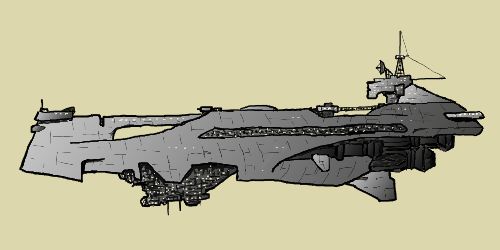
Darian Yards Autocrat class battleship. Note the typically Kuati bridge tower.
Bloody Winter- The name given to the uprisings on Kuat in 917 HR (Hegemony Reckoning). Started by political extremists and anarchists capitalising on war exhaustion and the bad supply situation on Kuat, workers and soldiers formed councils and expropriated House assets. They tried to storm the Reiksraade, but were beaten off by loyal troops. The last of those revolters were shattered before spring by hastily redeployed soldiers from the Denevar front.
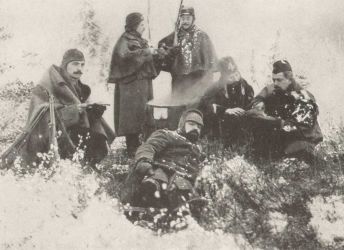
Loyalist soldiers and Fraajcorps share a meager hot meal during the defence of Kuat City, 917 HR
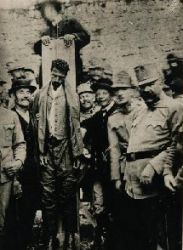
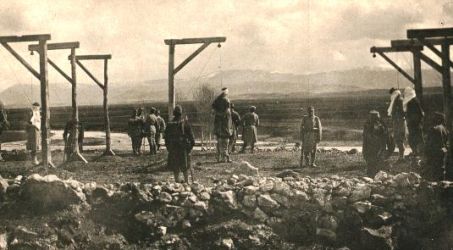
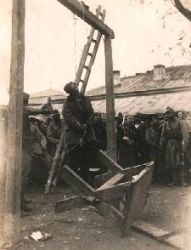
Cleaning up after the Bloody Winter, 918 HR.
Darian- River and River valley on Kuat. The House of Darian took its name from it during a time when the power of the nobility was rooted in land ownership.
Dromon class- A class of armored frigate built by Darian Yards during the early Republic era. 310m long, heavily armored, with an armored prow for ramming and a strong broadside armament.
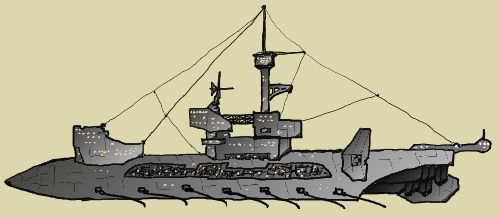
Darian Yards Dromon class armored frigate. Note the spars for the TORPEDO NETTING, believed at that time to protect from torpedo and missile attacks.
Hundred Families- The original Kuat nobility, with seats in the Reiksraade. Originally 100 Houses, by the time of the Clone Wars, their number had shrunk to only 67.
KMJP- Knight Master of the Jedi Praxium.
Kommandant- Ancient Kuati military rank. Equivalent to Lt. Colonel.
Komtur- Ancient Kuati military rank. Equivalent to Commodore.
Kuati Hegemony- The area of space under Kuati control before the forming of the Republic.
Long Wars- The wars that predated the forming of the Republic, 412-924 HR.
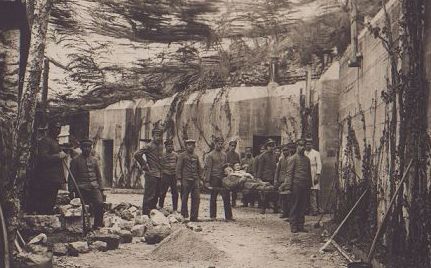

Left: Hegemony troops at MALGIL CITADEL, 614 HR. Right: Kuati Grenadiers leaving their trenches, ca. 910 HR.
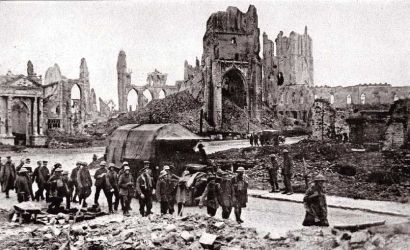
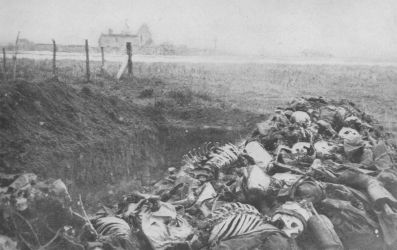
Left: Rheynar and Darian militias pass the ruins of an Alderaanian colony on Antaria, Adbrant, 467 HR. Right: Mass burial of fallen Coruscani soldiers on Corsin, 743 HR.
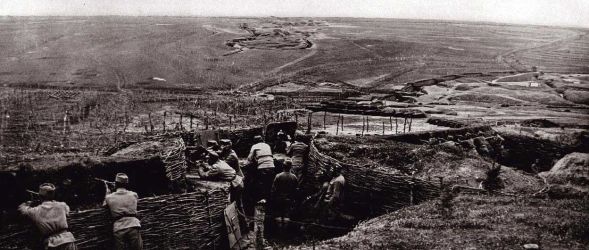
Kuati field fortifications on Denevar, 681 HR.
Pride class- A class of bulk transport built by Darian Yards during the early Republic era. 1270m long. The last Pride-class freighter was retired only 1100 years ago, testifying to the quality of Darian workmanship.
Reiksraade- The Kuati legislative assembly for the Hegemony and later the planet Kuat. Every Kuati Great House has a seat. Kuati senators to the Republic and later Imperial Senate were elected by them from their number.
telbun- A specially trained commoner selected as a spouse for a Kuati noble. Selected for favourable genetic traits. Due to this institution, Kuati nobles have avoided the degree of inbreeding so common among the Coruscani and Hapan aristocracy. While some Kuati nobles today decline to follow that tradition, they still would never choose another aristocrat, so strong is that prohibition ingrained in the Kuati psyche.
Time of Divided Realms- The semi-legendary time, when Kuat was split into several petty realms.
Vigilant- Imperial scout cruiser, vanished without trace in the Outer Rim on a survey mission. Presumed lost with all hands.
Wars of Unification- The series of wars that ended the Time of Divided Realms. Some of the earliest battles were still fought with projectile weapons and fossil fuel driven vehicles.
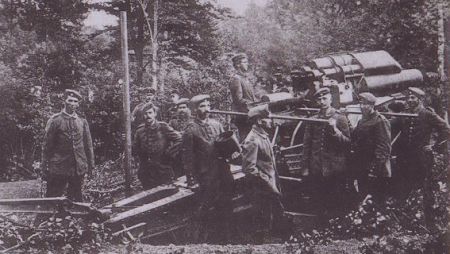
Darian and Vlandskrun militia with heavy gun, -32 HR.